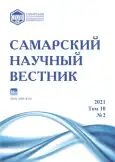Junior servants in the system of monastic administration at the beginning of the 17th century (on the example of the Joseph-Volokolamsk Monastery)
- Authors: Tseluykina E.S.1
-
Affiliations:
- Volgograd State University
- Issue: Vol 10, No 2 (2021)
- Pages: 159-166
- Section: Historical Sciences and Archaeology
- URL: https://journals.rcsi.science/2309-4370/article/view/78113
- DOI: https://doi.org/10.17816/snv2021102205
- ID: 78113
Cite item
Full Text
Abstract
The paper determines the place of junior servants in the system of monastic administration at the beginning of the 17th century on the example of the Joseph-Volokolamsk Monastery. At the beginning of the 17th century the Joseph-Volokolamsk Monastery suffered significant financial losses in connection with wartime conditions. At the same time, such a large patrimony had a need for a branched multistage management apparatus. The monastic servants carried out economic activities. The question of the system of monastic administration of the 16th–17th centuries actively researched by scientists on the example of specific monasteries. As part of the study of the Joseph-Volokolamsk Monastery, this problem was raised by historians on the basis of economic books of the 16th century. However, economic books of the beginning of the 17th century have also survived, which had not been studied earlier in this aspect, which made it possible to continue research in this area and expand the scientific understanding of the composition and role of monastic servants in the management structure of a large monastic patrimony. The sources for this work were two servage books of the Joseph-Volokolamsk Monastery, which are part of the economic books for the years of 7115 (1606/07) and 7116 (1607/08). To determine the place of monastic servants in the system of economic management, the classifications compiled by M.N. Tikhomirov, V.A. Petrov, S.I. Smetanina for the 16th century were considered and compared with the classifications by occupation and by territorial feature presented in the servage books of the early 17th century. This allowed us to conclude about the complexity of monastic servants classification structure at the beginning of the 17th century in comparison with the 16th century. A count was made of the number of monastic servants and the amounts spent on their maintenance to find out their composition. An attempt has been made to clarify the existing classifications of monastic servants for the beginning of the 17th century, while drawing attention to the merging of the system of senior and junior servants with an ordered control system. As a result of the study, it was concluded that a significant number of junior monastic servants (about 300) of various categories lived on the territory of the monastery, but their maintenance did not cause serious damage to the monastic treasury and was economically justified.
Full Text
##article.viewOnOriginalSite##About the authors
Evgeniya Sergeevna Tseluykina
Volgograd State University
Author for correspondence.
Email: tseluikina.eugenia@gmail.com
applicant of National and World History, Archaeology Department
Russian Federation, VolgogradReferences
- Приходо-расходные книги Иосифо-Волоколамского монастыря за 7114 (1605/06), 7115 (1606/07), 7116 (1607/08) гг.: [прил. к статье: Зимин А.А. К истории восстания Болотникова] // Исторические записки. 1947. Т. 24. С. 358–385.
- Зимин А.А. Крупная феодальная вотчина и социально-экономическая борьба в России (конец XV–XVI в.). М.: Наука, 1977. 356 с.
- Александрова Т.Л., Суздальцева Т.В. Преподобный Иосиф Волоцкий и созданная им обитель / под общ. ред. митрополита Волоколамского и Юрьевского Питирима. М.: Сев. Паломник, 2001. 80 с.
- Тихомиров М.Н. Монастырь-вотчинник XVI в. // Российское государство XV–XVII веков. М.: Наука, 1973. С. 120–154.
- Лохтева Г.Н. Половники Троице-Глединского монастыря в XVII в. // Исторические записки. 1962. Т. 72. С. 119–139.
- Огризко З.А. Слуги Спасо-Прилуцкого монастыря XVI–XVII веков // Из истории крестьянства XVI–XIX веков: сб. ст. Труды Государственного исторического музея. Вып. 27 / под ред. С.С. Дмитриева. М.: Госкультпросветиздат, 1955. С. 8–30.
- Путеводитель по архиву Ленинградского отделения Института истории. М.; Л.: Изд-во Акад. наук СССР. Ленингр. отд-ние, 1958. 603 с.
- Петров В.А. Слуги и деловые люди монастырских вотчин XVI в. // Вопросы экономики и классовых отношений в русском государстве XII–XVII веков: сб. науч. тр. М.; Л.: Изд-во АН СССР, 1960. С. 129–171.
- Смолич И.К. Русское монашество 988–1917. Жизнь и учение старцев. М.: Церков.-науч. центр «Православ. энцикл.», 1997. 297 с.
- Сметанина С.И. Хозяйственные книги Иосифо-Волоколамского монастыря в Российском государственном архиве древних актов (РГАДА) // История Волоколамского края и перспективы изучения «Золотого наследия Руси»: сб. докл. науч.-практ. конф., 30 окт. 1998 г. М.: РМАТ, 1999. С. 31–48.
- Комиссаренко А.И., Шамина И.Н. Монастырское хозяйство // Большая российская энциклопедия. В 30 т. Т. 20. М., 2012. С. 720–722.
- Кононов П.В. Монастырские слуги по приходо-расходным книгам Соловецкого монастыря XVI в. // Петербургский исторический журнал. 2016. № 2 (10). С. 131–138.
- Тихомиров М.Н., Флоря Б.Н. Приходо-расходные книги Иосифо-Волоколамского монастыря 1606/07 г. // Археографический ежегодник за 1966 год / АН СССР, Отд-ние истории, Археогр. комис. М.: Наука, 1968. С. 331–383.
- Приходо-расходная книга Иосифо-Волоколамского монастыря за 7115 (1606/07) г.: [приложение к статье: Бибиков Г.Н. Новые данные о восстании Болотникова] // Исторический архив. 1936. Т. 1. С. 12–22.
- Приходо-расходная денежная книга 1607–1608 гг. // Российский государственный архив древних актов (РГАДА). Ф. 1192. Оп. 2, ч. 1. Д. 19. 289 л.
- Целуйкина Е.С. Сельские приказы Иосифо-Волоколамского монастыря по оброчным книгам 1606–1608 гг. // XXIII регион. конф. молодых исследователей Волгоградской области, г. Волгоград, 17–21 дек. 2018 г. Волгоград: Изд-во ВолГУ, 2019. С. 50–52.
- Щепетов К.Н. Сельское хозяйство в вотчинах Иосифо-Волоколамского монастыря в конце XVI в. // Исторические записки. 1946. Т. 18. С. 92–147.
- Трезубов Е.С., Русакова Е.П. Эволюция поручительства в римском и российском обязательственном праве // Вестник Омского университета. Серия «Право». 2020. Т. 17, № 1. С. 82–93. doi: 10.24147/1990-5173.2020.17(1).82-93.
- Бибиков Г.Н. Новые данные о восстании Болотникова // Исторический архив. 1936. Т. 1. С. 5–24.
- Срезневский И.И. Материалы для словаря Древнерусского языка по письменным памятникам. В 3 т. Т. 1. А-К. СПб.: Тип. Императ. Акад. наук, 1893. 1420 стб.
- Дмитриева З.В. Хлебный «бюджет» Кирилло-Белозерского монастыря в начале XVII в. // Монастыри и архиерейские дворы в документах XVI–XVIII веков: сб. ст. Труды Санкт-Петербургского института истории РАН. СПб.: Нестор-История, 2015. С. 8–85.
Supplementary files






